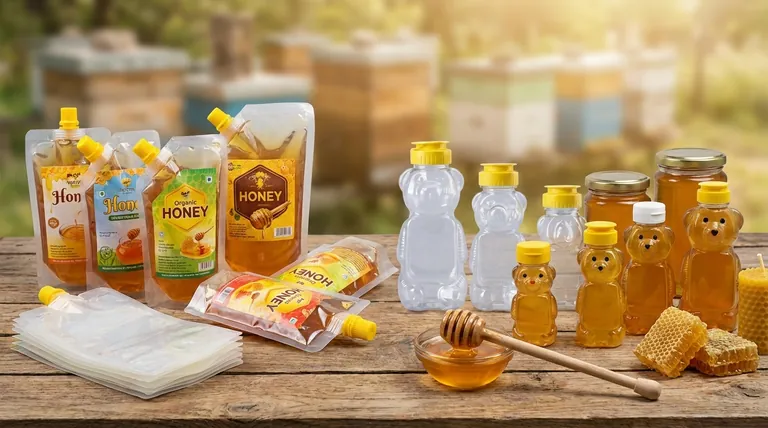At their core, honey pouches offer significant benefits in convenience, cost-efficiency, and branding flexibility. They are a lightweight, durable, and highly customizable packaging solution made from puncture-resistant materials like PET and laminates, making them ideal for modern logistics and on-the-go consumer products.
The choice between honey pouches and traditional glass jars is not a matter of which is superior, but which best aligns with your product's market position and your business's operational goals. Pouches excel in portability and cost reduction, while glass remains the standard for premium presentation and long-term preservation.

Why Pouches Are Gaining Popularity
Honey pouches solve several key challenges for producers and consumers, from reducing shipping costs to meeting demands for convenient, single-serving options.
Unmatched Convenience and Portability
Pouches are the ideal format for on-the-go consumption. Their lightweight nature and flexible design make them perfect for single-serving "honey sticks" or tear-off packets used in food service.
Features like spouts and resealable closures add a layer of convenience that rigid containers cannot easily match, minimizing waste and mess for the end-user.
Significant Cost and Efficiency Gains
Weight is a major factor in shipping costs. Pouches are substantially lighter than glass jars, leading to direct savings in transportation and logistics.
Furthermore, the automated filling and sealing processes for pouches can reduce labor costs and increase throughput, ensuring consistent and efficient production lines.
Superior Customization and Branding
The entire surface of a pouch is a printable canvas, offering vast real estate for vibrant, eye-catching branding that appeals directly to consumers on a crowded shelf.
Beyond graphics, pouches can be customized with unique shapes, handles, and dispensing features, allowing a brand to differentiate its product functionally as well as visually.
Durability for Modern Logistics
Modern honey pouches are engineered from durable, multi-layered materials including polyethylene (PE), polyethylene terephthalate (PET), and foils.
This construction makes them highly resistant to punctures and damage during transit, a crucial advantage over glass, which can shatter.
Understanding the Trade-offs: Pouches vs. Glass Jars
While pouches offer many advantages, they are not the right choice for every situation. Understanding their limitations compared to traditional glass is critical for making an informed decision.
Product Preservation and Shelf Life
Glass is an inert, non-porous material. It provides a superior barrier against moisture and gases, protecting honey's authentic flavor, preventing crystallization, and reducing fermentation risks over the long term.
Pouches, while protective, typically offer less robust protection for long-term storage. They are best suited for products with a faster expected consumption cycle.
Consumer Perception and Brand Image
Glass jars convey a sense of premium quality, tradition, and purity. The transparency of glass allows consumers to see the honey's color and texture, which serves as a powerful marketing tool.
Pouches are often associated with convenience, modernity, and value. This perception can be an asset for certain market segments but may not align with a high-end, artisanal brand identity.
Environmental Impact
Glass is infinitely recyclable, a clear and simple sustainability message for consumers.
The recyclability of flexible pouches is more complex. While many are technically recyclable, they often require specialized collection streams that are not widely available to the average consumer.
How to Choose the Right Packaging for Your Goal
Your packaging choice should be a strategic decision that supports your product's purpose and your brand's identity.
- If your primary focus is on-the-go convenience or food service: Pouches are the definitive choice for single-servings, portability, and ease of use.
- If your primary focus is premium branding and long-term preservation: Glass jars remain the industry standard for showcasing artisanal quality and ensuring maximum shelf life.
- If your primary focus is reducing shipping costs and improving logistical durability: Pouches provide a clear advantage with their lightweight and puncture-resistant properties.
Ultimately, the right packaging does more than just hold your product; it communicates its value and purpose to the world.
Summary Table:
| Benefit | Key Advantage | Ideal For |
|---|---|---|
| Convenience & Portability | Lightweight, flexible, single-serving formats | On-the-go consumers, food service |
| Cost Efficiency | Lower shipping weight, automated filling | Reducing operational costs |
| Branding & Customization | Full printable surface, unique shapes | Eye-catching shelf presence |
| Durability | Puncture-resistant materials (PET, laminates) | Safe transit and handling |
Ready to optimize your honey packaging? As a trusted supplier to commercial apiaries and distributors, HONESTBEE provides high-quality, customizable honey pouches that reduce your costs and enhance your brand's appeal. Contact us today to discuss wholesale solutions tailored to your operation!
Visual Guide

Related Products
- Classic Honey Bear Jars with Flip Top Dispensing Cap for Liquid Sweeteners
- Food Grade Plastic Honey Bucket Pail for Beekeeping
- Hexagonal Glass Honey Jars with Metal Lug Caps Elegant Versatile Packaging
- Inverted Squeezable Honey Jar with No Drip Flip Top Cap for Easy Pouring
- Classic Drum Shaped Glass Honey Jar with Airtight Lid
People Also Ask
- What is done with the honey after extraction and filtering? From Purification to Perfect Packaging
- How should honey bottles be prepared before pouring honey into them? The #1 Rule for Honey Longevity
- Can honey go bad in the heat? Protect Your Honey's Quality and Flavor
- How does honey get packaged? Preserve Quality and Boost Appeal
- What are the common types of honey packaging? A Guide to Glass, Plastic, Pouches & Tins



















